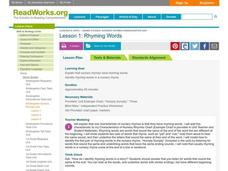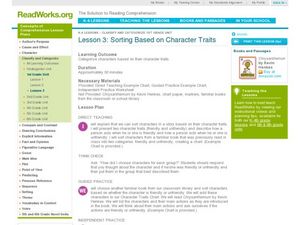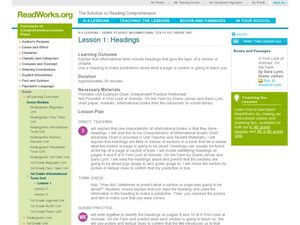Curated OER
Good and Evil Characters
What makes a character good or evil? Young readers discuss the characteristics and actions of good and evil characters in given fairy tales. They then read Snow White and discuss the characters in the story.
Curated OER
Fantasy Details
Students identify fantasy details from a fairy tale they have read and give an explanation of how they know it is a fantasy detail. In this fantasy detail lesson plan, students make a list from the fairy tale Little Red Riding Hood.
Curated OER
Pictures and Photographs
Learners write the facts that they learned from the photographs in the book All About Cats and Kittens. In this pictures and photographs lesson plan, students present their fact to the class and add it to the chart.
Curated OER
Rhyming Words
Examine the rhyming words in nursery rhymes. Kids identify rhyming words by looking at the end spelling, and underline the parts of the words that are the same. They then complete guided practice and independent practice.
Curated OER
Characters
Bring a lesson on nursery rhymes to your kindergarten class room. Kids listen to Three Blind Mice and identify the characters. They then decide which parts of the story make it a nursery rhyme. For extra practice, use the same activity...
Curated OER
What the Book is Mainly About
Students analyze the title, text, and pictures to determine the main idea. In this language arts lesson plan, students predict the main idea by looking at various features of the book. As students listen to the story, they illustrate and...
Curated OER
Identifying the Problem and the Solution in a Story
Story elements: the problem and the solution. Help your youngsters identify these elements by reading Bringing Down the Moon, by Jonathan Emmett. After a class discussion and chart creation discussing problems and solutions from past...
Curated OER
Identifying the Solution in a Story
Using the book My Red Balloon by Eve Bunting, Kindergartners will gain an understanding that stories often have solutions. Using Eve Bunting's book as an example the teacher will identify the solution to the story and walk the students...
Curated OER
Repeated Text
Students examine repeated text to predict the outcome of a story. In this language arts lesson, students read a story and use the repeated language to make predictions about what will happen next in the story.
Curated OER
Beginning and End
Are you working onevent sequence in your kindergarten class? Use a reading activity to have your kids discuss events from the story, and put them in order. They then cut and paste them in the correct order. A great project for any story!
Curated OER
When (Seasons, Day, or Night)
Practice identifying the setting with a reading activity. Kindergartners find the setting of a story by observing when the story takes place. They read the book Look! Snow! by Kathryn O. Galbraith and decide in which season the story...
Curated OER
Lesson 1: Actions
Action is what characters in books do or say. Little ones discuss what actions are and then examine the book David, No! to identify them. As they read through the book, they chart all of David's actions. They write a sentence and draw a...
Curated OER
Sorting Based on Character Traits
Characters from a story can be sorted by their traits, just like shapes or objects can. First the children list several character traits on a chart, they read a familiar story, and then sort the characters by their friendly or unfriendly...
Curated OER
Lesson 3: Comparing and Contrasting two Characters from a Book
One book, two main characters, and a Venn diagram; it's time to discuss similarities and differences in order to compare and contrast two characters from the same book. The class listens to the book Toot and Puddles as they complete a...
Curated OER
Text Clues and Background Knowledge
Teach youngsters how to evaluate background knowledge, pictures, and context clues to draw a reasonable conclusion about a story. They practice using the discussed clues as they read the story, Alexander and the Terrible, Horrible, No...
Curated OER
Identifying Information from Fiction
A solid comprehension strategy is used to aid learners in better understanding what they read. They are introduced to the way good readers ask questions while their reading to understand what's going on in a story. The class reads...
Curated OER
Identifying Opinions with Signal Words
First graders identify opinions within a text. In this language arts instructional activity, 1st graders discuss the definition of opinion. Students identify words that signal opinions and work together to identify opinions within the text.
Curated OER
Identifying Facts
Students evaluate what a fact is and what the characteristics of a fact are. In this fact and opinion lesson, students read through chapters in their books and point out facts that they find that cannot be disputed.
Curated OER
Form an Opinion Based on Facts
Explore fact and opinion through higher level thinking and literacy. Kids listen to the beginning of A Picture Book of Helen Keller by David A. Adler and identify facts in the text. They follow along as the teacher models how to form an...
Curated OER
Historical Period
Students identify and describe ways in which life was different in the time historical period of Rosa Parks. In this historical time period lesson plan, students explain that one characteristic of a biography is that it takes place in a...
Curated OER
Headings
First graders discover how heading help us make predictions. The class discusses how informational text typically has heading that can aid them in determining what a chapter will be about. They read the heading and make predictions for...
Curated OER
Table of Contents and Index
Have your class investigate the use of a table of contents and index to find information. They identify characteristics of informational books and add them to a chart, then demonstrate how to use the index and table of contents by trying...
Curated OER
Cultural Background
First graders pick out cultural details from the story The Legend of the Indian Paintbrush. In this culture lesson plan, 1st graders discuss how legends come from cultures that have traditions.
Curated OER
Lesson 3: Gods and Goddesses
Exploring and characterizing myths can be fun. The class reads a version of "Pandora's Box," add to their myth chart, and discuss how gods and goddesses are commonly used in mythology. They work in groups to identify the gods and...

























